The fighting game genre of video game involves combat between multiple characters. Fighting game combat often features mechanics such as blocking, grappling, counter-attacking, and chaining attacks together into "combos". Characters generally engage hand-to-hand combat, often with martial arts. The fighting game genre is distinctly related to the beat 'em up genre, which pits many computer-controlled enemies against one or more player characters.
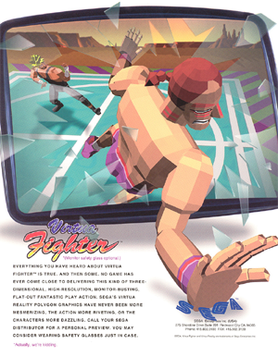
Virtua Fighter is a fighting game created for the Sega Model 1 arcade platform by AM2, a development group within Sega, headed by Yu Suzuki. An early prototype version was location tested in Japan by August 1993, before the complete game was released worldwide in December 1993. It was the first arcade fighting game to feature fully 3D polygon graphics. The game was ported to Sega Saturn as a global launch title in 1994 and 1995, and also received a port to the Sega 32X.
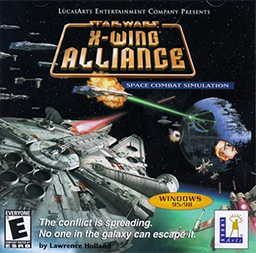
Star Wars: X-Wing Alliance is a 1999 space simulation video game, the sequel to both Star Wars: TIE Fighter and Star Wars: X-Wing vs. TIE Fighter. X-Wing Alliance presents the story of the Azzameen family, a family of space traders. The player assumes the role of Ace Azzameen, the youngest of the Azzameen children, juggling military duty as a fighter pilot for the Rebel Alliance, and allegiance to his family, flying larger heavily armed freighters for the family business, amid a bloody family feud and in the larger context of a galactic civil war. It received favorable reviews.

Street Fighter II: The World Warrior is a 1991 fighting game produced by Capcom for arcades, and their fourteenth game to use the CP System arcade system board. It is the second installment in the Street Fighter series and the sequel to 1987's Street Fighter. Street Fighter II vastly improved many of the concepts introduced in the first game, including the use of special command-based moves, a combo system, a six-button configuration, and a wider selection of playable characters, each with a unique fighting style.

Panzer General is a 1994 computer wargame developed and published by Strategic Simulations Inc. (SSI). It simulates conflict during World War II. The designers of Panzer General were heavily influenced by the Japanese wargame series Daisenryaku.

Super Street Fighter II: The New Challengers is a 1993 competitive fighting game produced by Capcom and originally released as an arcade game. It is the fourth game in the Street Fighter II sub-series of Street Fighter games, following Street Fighter II: Hyper Fighting (1992). It refines and balances the existing character roster from the previous versions, and introduces four new characters, including Cammy and Dee Jay. It is the first game on Capcom's CP System II hardware, with more sophisticated graphics and audio over the original CP System hardware used in previous versions of Street Fighter II.
1996 saw many sequels and prequels in video games, such as Super Mario 64, Duke Nukem 3D, Street Fighter Alpha 2, Super Mario RPG, King's Field III, Virtua Fighter 3, along with new titles such as Blazing Heroes, NiGHTS into Dreams..., Crash Bandicoot, Pokémon Red/Green/Blue, Resident Evil, Dead or Alive, Soul Edge, Quake and Tomb Raider.
1994 saw many sequels and prequels in video games, such as Super Metroid, Donkey Kong Country, Final Fantasy VI, Sonic 3 & Knuckles, Super Street Fighter II Turbo and Virtua Fighter 2 and Doom II, along with new titles such as Daytona USA, Ace Driver, Alpine Racer and Tekken.

Virtua Fighter 2 is a 1994 fighting video game by Sega. It is the sequel to Virtua Fighter (1993), and the second game in the Virtua Fighter series. Created by Sega's Yu Suzuki-headed AM2 team, it was designed on the purpose-made Sega Model 2 hardware which provided a significant upgrade in graphical capabilities. Following its release on the arcades, Virtua Fighter 2 was ported to the Sega Saturn home console in November 1995, while ports for some other platforms appeared later.
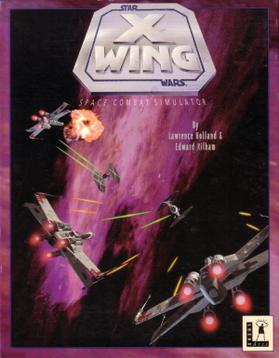
Star Wars: X-Wing is a space simulation video game, the first of the X-Wing combat flight simulation games series. The player's character flies starfighters, including the X-wing, for the Rebel Alliance. The narrative precedes and parallels the events of Star Wars Episode IV: A New Hope.

Achtung Spitfire! is a 1997 computer wargame developed by Big Time Software and published by Avalon Hill. It is a turn-based air combat game taking place during the early half of World War II, including fixed-wing aircraft, air battles and operations by Luftwaffe, Royal Air Force and French Air Force in 1939–1943.

Wing Commander is the first game in Chris Roberts' space flight simulation Wing Commander franchise by Origin Systems. The game was first released for MS-DOS on September 26, 1990, and was later ported to the Amiga, CD32 (256-color), Sega CD and the Super Nintendo Entertainment System, and re-released for the PC as Wing Commander I in 1994. An enhanced remake Super Wing Commander was made for the 3DO in 1994, and later ported to the Macintosh.
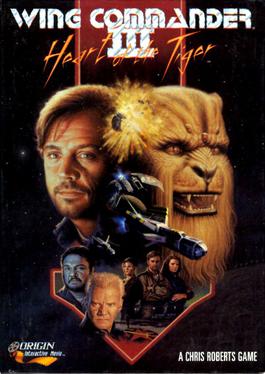
Wing Commander III: Heart of the Tiger is the third main game in Chris Roberts' Wing Commander science fiction space combat simulation video game series, developed and released by Origin Systems in December 1994. It was a departure from previous games in the series in that it uses extensive live action full-motion video to add an interactive movie-style presentation to the space combat gameplay, emphasized by its advertising slogan, "Don't watch the game, play the movie!". The game's more than two hours of video featured a number of prominent movie stars including Mark Hamill as Colonel Christopher "Maverick" Blair, Malcolm McDowell as Admiral Tolwyn, John Rhys-Davies as James "Paladin" Taggart and Thrakhath nar Kiranka, and Tom Wilson as Todd "Maniac" Marshall.
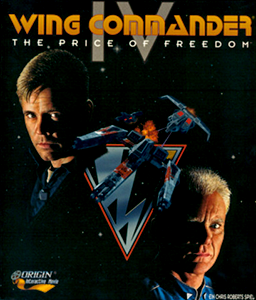
Wing Commander IV: The Price of Freedom is the fourth main game in the Wing Commander science fiction space combat simulator video game series, produced by Origin Systems and released by Electronic Arts for the PC in 1996 and the Sony PlayStation in 1997.
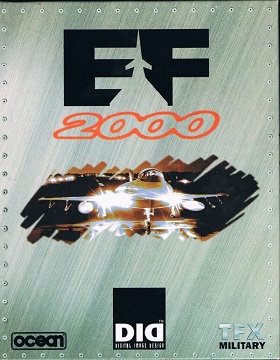
EF2000 is a combat flight simulator video game developed by Digital Image Design (DID) and published by Ocean Software in 1995 for the PC DOS. It is the sequel to DID's earlier software title, TFX. An expansion pack, EF 2000: TACTCOM, was released in 1996. A compilation, EF 2000: Evolution, that included the main game and the expansion was released in 1996. An updated version, Super EF2000, was released exclusively for Windows 95 in 1996 in Europe. In 1997, a compilation titled EF2000 V2.0 was released in North America that included the original DOS versions of EF2000 and TACTCOM and also the Windows exclusive Super EF2000. In June 1997, the graphics were boosted when DID released the "Graphics+" patch, which added Rendition Vérité hardware support and Glide API for 3dfx graphics card support to EF2000.

Tekken (鉄拳) is a 1994 fighting game developed and published by Namco. It was originally released on arcades, then ported to the PlayStation home console in 1995. One of the earliest 3D polygon-based games of the genre, Tekken was Namco's answer to Virtua Fighter and was designed by Seiichi Ishii, who himself was also Virtua Fighter's designer when he worked at Sega previously. The game was developed on the purpose-built low-cost System 11 board, based on PlayStation hardware.

Star Wars: TIE Fighter is a 1994 Star Wars space flight simulator and space combat video game, a sequel in the Star Wars: X-Wing series. It places the player in the role of an Imperial starfighter pilot during events that occur between The Empire Strikes Back and Return of the Jedi.

Street Fighter Alpha: Warriors' Dreams, known as Street Fighter Zero in Japan, Asia, South America, and Oceania, is a 2D arcade fighting game by Capcom originally released in 1995 for the CP System II hardware. It was the first all new Street Fighter game produced by Capcom since the release of Street Fighter II in 1991. Plotwise, it serves as a prequel to Street Fighter II and thus features younger versions of established characters, as well as characters from the original Street Fighter and Final Fight.

Warcraft II: Tides of Darkness is a fantasy real-time strategy computer game developed by Blizzard Entertainment and released for MS-DOS and Microsoft Windows in 1995 and Mac OS in 1996 by Blizzard's parent, Davidson & Associates. A sequel to Warcraft: Orcs & Humans, the game was met with positive reviews and won most of the major PC gaming awards in 1996. In 1996, Blizzard released an expansion pack, Warcraft II: Beyond the Dark Portal, for DOS and Mac OS, and a compilation, Warcraft II: The Dark Saga, for the PlayStation and Sega Saturn. The Battle.net edition, released in 1999, included Warcraft II: Beyond the Dark Portal, provided Blizzard's online gaming service, and replaced the MS-DOS version with a Windows one.

Shin Kidō Senki Gundam Wing: Endless Duel is a 1996 fighting video game developed by Natsume Co., Ltd. and published in Japan by Bandai for the Super Famicom. It is the first game to be based on the Mobile Suit Gundam Wing anime series. Set in the year After Colony 195, players take control of a pilot from the Colony Liberation Organization or the Organization of the Zodiac. Its gameplay consists of one-on-one fights, with a main four-button configuration, featuring special moves, as well as three playable modes.

















